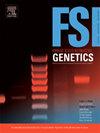An overview of the mtDNA diversity across the Colombian Andean region
IF 3.1
2区 医学
Q2 GENETICS & HEREDITY
引用次数: 0
Abstract
In Colombia, a country in the northwest corner of South America, populations are highly diverse due to the intercontinental admixture of Native Americans, European settlers, and enslaved Africans. While genetic diversity has been largely assessed based on autosomal markers, studies on mtDNA are much scarcer, allowing only a fragmentary view of the distribution of maternal lineages in the country. In this study the genetic diversity of maternal lineages in Colombian Andean populations was interrogated to infer whether the pattern of structuring was in line with the different colonization histories of the departments within the region. The ultimate goal was to establish a haplotype database for forensic purposes. In a total of 458 individuals born and residing in the departments of the Andean region, haplotypes of the total mtDNA control region were determined and assigned to the corresponding haplogroups. Across the 10 departments, haplotype diversities ranged between 0.9665 and 0.9967, and power of exclusion between 0.9208 and 0.9845. A component ascribed to be of Native American ancestry prevailed in all departments, where 89.27 % of haplotypes in the total sample belonged to mtDNA macro-haplogroups A2, B4, C1, and D. The remaining lineages were of Eurasian (6.65 %) or African (4.08 %) origin. Pairwise FST values showed signs of genetic differentiation, but still only reached statistical significance when Risaralda or Cundinamarca were compared with other populations. Principal component analysis showed that the population structure was mainly due to some differences in Native American substrates. The results obtained highlighted a heterogeneity within Andean populations that must be considered when developing mtDNA haplotype databases for forensic purposes. In this context, the use of specific databases is recommended for the departments of Risaralda and Cundinamarca, while the other departments can rely on a single haplotype frequency database.
哥伦比亚安第斯地区mtDNA多样性概况
在哥伦比亚,一个位于南美洲西北角的国家,由于美洲原住民、欧洲移民和被奴役的非洲人的洲际混合,人口高度多样化。虽然遗传多样性在很大程度上是基于常染色体标记进行评估的,但对mtDNA的研究要少得多,只能对该国母系的分布进行零碎的观察。在这项研究中,研究人员询问了哥伦比亚安第斯人群母系的遗传多样性,以推断其结构模式是否与该地区各部门的不同殖民历史相符。最终的目标是建立一个用于法医目的的单倍型数据库。在安第斯地区出生和居住的458个个体中,确定了总mtDNA控制区的单倍型,并将其分配到相应的单倍群中。10个部门的单倍型多样性在0.9665 ~ 0.9967之间,排除力在0.9208 ~ 0.9845之间。在所有部门中,美洲原住民祖先的成分占主导地位,其中89.27 %的单倍型属于mtDNA大单倍群A2、B4、C1和d,其余谱系为欧亚血统(6.65 %)或非洲血统(4.08 %)。两两FST值表现出遗传分化的迹象,但仅在Risaralda或Cundinamarca与其他群体比较时才达到统计学意义。主成分分析表明,种群结构主要是由于美洲原住民底物的差异造成的。所获得的结果突出了安第斯人群的异质性,这是在为法医目的开发mtDNA单倍型数据库时必须考虑的。在这种情况下,建议对Risaralda和Cundinamarca部门使用特定的数据库,而其他部门可以依赖单一的单倍型频率数据库。
本文章由计算机程序翻译,如有差异,请以英文原文为准。
求助全文
约1分钟内获得全文
求助全文
来源期刊
CiteScore
7.50
自引率
32.30%
发文量
132
审稿时长
11.3 weeks
期刊介绍:
Forensic Science International: Genetics is the premier journal in the field of Forensic Genetics. This branch of Forensic Science can be defined as the application of genetics to human and non-human material (in the sense of a science with the purpose of studying inherited characteristics for the analysis of inter- and intra-specific variations in populations) for the resolution of legal conflicts.
The scope of the journal includes:
Forensic applications of human polymorphism.
Testing of paternity and other family relationships, immigration cases, typing of biological stains and tissues from criminal casework, identification of human remains by DNA testing methodologies.
Description of human polymorphisms of forensic interest, with special interest in DNA polymorphisms.
Autosomal DNA polymorphisms, mini- and microsatellites (or short tandem repeats, STRs), single nucleotide polymorphisms (SNPs), X and Y chromosome polymorphisms, mtDNA polymorphisms, and any other type of DNA variation with potential forensic applications.
Non-human DNA polymorphisms for crime scene investigation.
Population genetics of human polymorphisms of forensic interest.
Population data, especially from DNA polymorphisms of interest for the solution of forensic problems.
DNA typing methodologies and strategies.
Biostatistical methods in forensic genetics.
Evaluation of DNA evidence in forensic problems (such as paternity or immigration cases, criminal casework, identification), classical and new statistical approaches.
Standards in forensic genetics.
Recommendations of regulatory bodies concerning methods, markers, interpretation or strategies or proposals for procedural or technical standards.
Quality control.
Quality control and quality assurance strategies, proficiency testing for DNA typing methodologies.
Criminal DNA databases.
Technical, legal and statistical issues.
General ethical and legal issues related to forensic genetics.

 求助内容:
求助内容: 应助结果提醒方式:
应助结果提醒方式:


